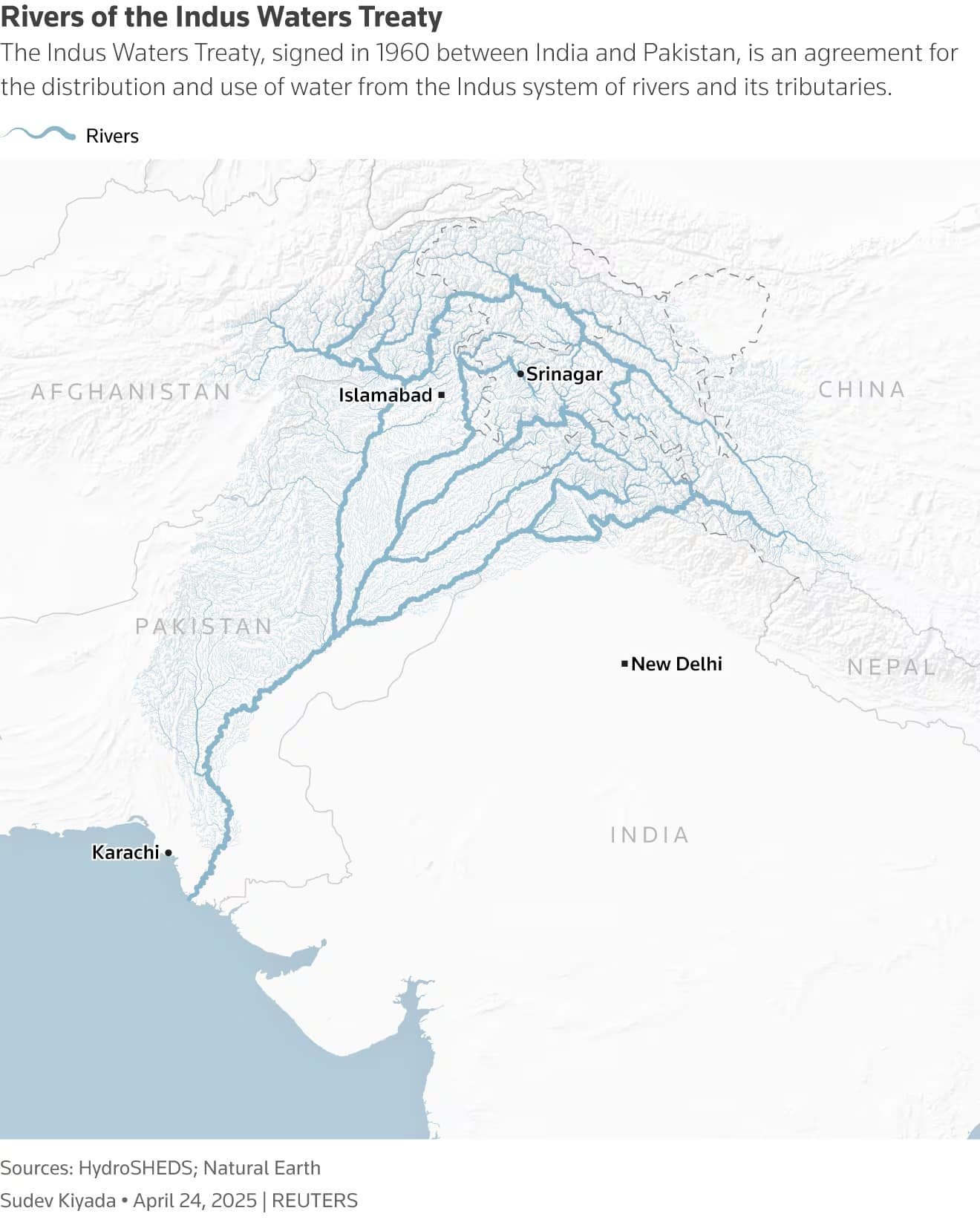The Indus Waters Treaty (IWT) was signed in 1960 with the help of the World Bank. It was meant to stop water fights after 1947, when India and Pakistan split. The treaty gives Pakistan rights over the western rivers (Indus, Jhelum, Chenab) and India control over the eastern rivers (Ravi, Beas, Sutlej). That meant each country could build farms and towns without hurting the other.
To manage problems, it set up the Permanent Indus Commission, where officials from both sides meet to solve issues. If that fails, a Neutral Expert or Court of Arbitration steps in. This treaty has survived wars and kept water flowing for both nations.

Image Credit: ISSI
Modern Problems and Rising Tension
In April 2025, after a deadly attack in Kashmir, India suspended the treaty, citing security reasons. It temporarily stopped sharing vital river data and paused treaty functions. Pakistan called this a serious threat.
Experts warn that this is dangerous. Pakistan relies on these rivers for 80% of its farm water, electricity, and drinking needs. Any cut in access could hurt farmers, power plants, and cities like Lahore and Karachi.
By summer 2025, Pakistan’s dams were at “dead” levels. The threat of water shortages loomed large amid growing heatwaves and dry spells.
Climate Change: A Growing Crisis
India and Pakistan now face bigger threats from climate change. Melting glaciers, shifting monsoon patterns, floods, and droughts are becoming common in the Indus Basin.) By 2025, Pakistan’s per-person water availability dropped below 500 cubic meters, a level deemed “absolute scarcity.”
Scientists warn that the river basin could lose nearly 50% of its water by 2030 if temperatures continue rising and ice melts faster. Rivers will flood more often and then dry up, affecting farms, cities, and people.
Environmental Toll on the Delta and Ecosystem
Pakistan’s Indus River Delta has shrunk by 92% since 1833. Reduced freshwater means more saltwater pushes in, killing plants and fish. Dolphin populations are cut off by dams. Pollution and trash float in from cities like Karachi, making things worse. Over 1.2 million people have fled delta areas like Kharo Chan. Farmland has vanished, fishing is wasted, and communities are left with nowhere to go. The government and the UN are working to restore the ecosystem, but time is short.
You May Like To Read:
- Information as a Weapon: How ISI Shapes Perception in War
- How PTV Dramas Shaped Pakistan’s Culture
- A Poet of Many Languages, One Heart: Remembering Sufi Tabassum
A Call to Restore and Revive
In response, Pakistan launched the Living Indus Initiative with the UN. It is a big plan to revive the river’s ecosystems, recharge groundwater, plant trees, and restore wetlands. It is one of the world’s biggest environmental programs of this kind.
This initiative shows how the state is working for tomorrow—not just angry words, but real action.
Why the Treaty Still Matters?
Despite years of political tension, the Indus Waters Treaty remains one of the most enduring examples of peace and cooperation between India and Pakistan. It is rare in our region to have a formal pact that survives wars, disputes, and even periods of no diplomatic contact. Yet, for more than six decades, this agreement has ensured that water continues to flow across borders. It has allowed both countries to build their farms, run their turbines, and feed their people without sliding into open conflict over rivers.
This treaty is more than a legal document; it is a lifeline. In Punjab and Sindh, farmers rely on steady river flows for their wheat, rice, and cotton crops. Hydropower plants along the Indus and its tributaries utilize this water to illuminate rural homes and sustain small industries. Urban centers benefit too, with millions relying on the western rivers for drinking water. Without the treaty’s safeguards, these flows could be cut, leaving crops to wither and communities in crisis.
Trust, while fragile, has been tested and proven. In past disputes over Indian dam projects, both sides have used the treaty’s built-in negotiation tools and arbitration processes to prevent escalation. These mechanisms work because both nations recognize that water security is too important to risk.
For Pakistan, the treaty is not just about water rights; it is about national stability and food security. As climate change and political pressures grow, the Indus Waters Treaty remains a vital shield, protecting our fields, our homes, and our future. Keeping it alive is in the interest of peace and prosperity for the entire region.
A Fair Future for Pakistan and Peace
The Indus Waters Treaty is not just a paper. It is a promise. A promise that water flows, even when politics freeze. A promise that farmers survive and cities thrive together.
Modern threats, climate change, drought, and the Delta crises test this promise. India’s suspension and climate shifts make life harder. But Pakistan is responding. It’s building the Living Indus, protecting its delta, and urging global and regional dialogue.
As long as both countries abide by law, not force, the Indus can remain a source of life, not of conflict.
This is the Pakistan that Quaid envisioned—a nation that waters its land, feeds its people, and honors its agreements. The path forward is clear: guard the treaty, adapt to the climate, and give our rivers the respect they deserve.







